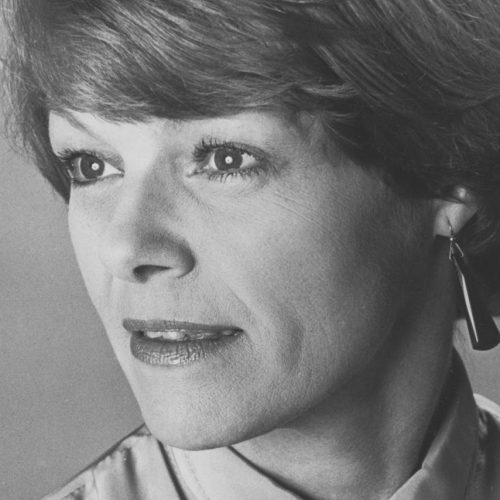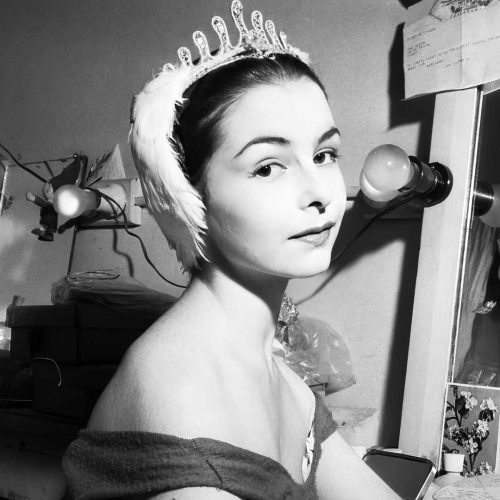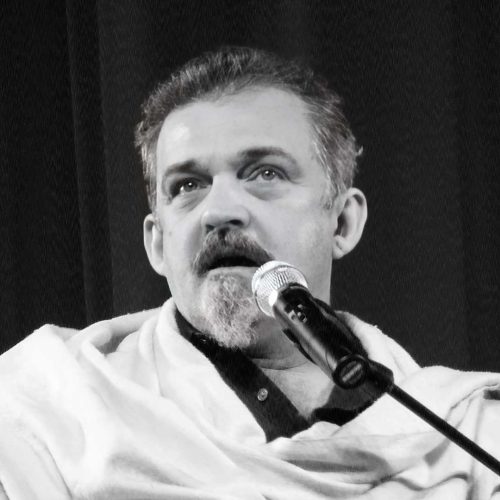Romayne Grigorova
Romayne Grigorova had a long, distinguished career in ballet and the theatre. Here, in conversation with Patricia Linton, founder and director of Voices of British Ballet, she focuses on her early years, much of which was coloured by World War Two. In 1943, after training at the Sadler’s Wells Ballet School, she worked with the Sadler’s Wells Opera on The Bartered Bride in London during the Blitz and on tour. In 1945 she travelled to Germany with the opera under the auspices of ENSA. She then joined Ballet Rambert, and went to Germany again, to Berlin, where she delivered food parcels to a German singer and her family in the Russian zone, and scissors to Lotte Reiniger, a famous German film director and pioneer of silhouette animation. Romayne Grigorova also speaks of her dealings with Marie Rambert and Andrée Howard, joining Sadler’s Wells Theatre Ballet in 1951 and touring to North America.
The interview was recorded in 2003, and is introduced by Monica Mason. The podcast introduction was recorded before Romayne Grigorova’s death in July 2025.
First published: November 25, 2025
Biography
Romayne Grigorova was born in Sandwich, Kent, in 1927. She studied under Vera Volkova, Ninette de Valois, George Goncharov and Ailne Philips. Her first appearance on the professional stage was in 1942. In 1943, after training at the Sadler’s Wells Ballet School for a further year, she danced in ballets with the Sadler’s Wells Opera in this country and, in 1945, on tour in Germany under ENSA. She joined Ballet Rambert in 1946 and then danced with the Anglo-Polish and Metropolitan Ballets until 1947, when the latter folded.
Grigorova then worked in the commercial theatre until 1951, including performing in three pantomimes, before joining Sadler’s Wells Theatre Ballet, where she remained until 1955. She was ballet mistress for the stage musical Can-Can in 1955, and for the St Gallen Ballet in 1956. In 1957 she became ballet mistress for the Opera Ballet at the Royal Opera House, for whom she choreographed many ballets. She retired from this post in 1992 but continued to teach on a freelance basis. She performed small character roles with The Royal Ballet at Covent Garden, many of which had been created for her, such as Lady Montague in Kenneth MacMillan’s Romeo and Juliet and The Housekeeper in Peter Wright’s The Nutcracker. Romayne Grigorova was appointed an MBE for her services to dance in 2017.
Transcript
in conversation with Patricia Linton
Romayne Grigorova: I made my first appearance on the professional stage in 1942, and I suppose I was 15 then. Would I have been? Or 16?
Patricia Linton: And it was after that that you joined the Sadler’s Wells [Ballet] School?
Romayne Grigorova: I went back, no, for one more year. I did my advanced exam but, not knowing the results, I went up to London. Ailne Phillips was a lovely teacher. Cecchetti trained, very strict, but she also had her own way of teaching. And the other teacher for our class was Vera Volkova, and we, we adored her. My very first few months there we were already rehearsing The Bartered Bride, the opera which Sasha Markov was the choreographer, and we would have worked to death for him cos it was very exciting and also the opera went in, I think it was November, of 1943: bombs still going about, in the New Theatre, which is now the Albery, isn’t it?
We went out on tour with The Bartered Bride, and we were billeted in factory hostels. I think we were paid half a crown a week, or something, and our make-up was paid for. We thought it was absolutely wonderful. Pamela May was the principal dancer – a character dance in The Bartered Bride, the polka. Sasha Markov was asked who he would like to use as his partner and he saw, through the window of the ballet studio, Pamela May was just coming back from having had a baby and he fell in love with her on sight and, although she’d never done character – maybe it wasn’t her forte in the repertoire – she was absolutely lovely and we were thrilled to dance with, on the same dance as Pamela May. She was very sweet to us, and I’ll always remember that. But, of course, when the war ended, 1945, in the September of that very year we were put with ENSA to go to Germany to entertain the troops with The Bartered Bride, plus Madam Butterfly.
Patricia Linton: This was still under the auspices of Sadler’s Wells Ballet?
Romayne Grigorova: It was still Sadler’s Wells, yes, but I think the new company, the new Sadler’s Wells Theatre Ballet was being formed. I didn’t really think, being rather old, that I would stand much chance, but meantime, Vera Volkova’s outside class, Angela Ellis, Madam Rambert’s daughter, asked me if I was interested also going with ENSA to Germany with the Ballet Rambert. So, of course I was interested.
Patricia Linton: So, you did actually go with ENSA and the Sadler’s Wells Ballet, and then you went again with Rambert?
Romayne Grigorova: Again with the Rambert. We had a very interesting time there. When the singers of the Sadler’s Wells Ballet knew I was going back to Berlin I was given food parcels – please can you take this [to] Tiana Lemnitz? But it was quite an adventure because Tiana Lemnitz lived in the Russian zone and I’ll never forget a sweet dancer in the Ballet Rambert – Newman – I can’t remember his Christian name, but he accompanied me to the Russian zone, and it was quite a dangerous thing to do. And we found the front door, knocked on the door and Tiana Lemnitz herself answered the door, and she said to her old mother, “Oh, look what Father Christmas has brought us!” And it was tins of pilchards, cocoa, you know, and for them, they were really starving then.
In Berlin I saw some little silhouette cut-outs in a shop window and the name was Lotte Reiniger. Just before the war she made wonderful cut-out figure films of ballets and operas, and I met her and we got her to come into the wings to watch the Ballet Rambert, and she was so thrilled. I also – not food – but I took her a pair of scissors from the singer Anna Pollock. Would I give these to Lotte Reiniger? There and then she cut me, with just the scissors, no drawing, [Les] Sylphides pas de deux couple, the tutu and everything. I’ve still got it.
Patricia Linton: And can you remember the rep[ertoire] you took with Ballet Rambert at that time?
Romayne Grigorova: Second Act of Giselle. Two ballets of Walter Gore – he was there then. I didn’t ever hear him speak a word, excepting he used to take class, when Madam Rambert wasn’t today, we used to alternate. He just very quietly said the steps. They used to sit on the train next to each other, Sally [Gilmour] and he, I never heard him speak.
I would love to mention the artist Joyce Graeme, who was our Queen of the Wilis. Tall, slim, almost bony, and she put on green make-up to make her look as if she’d come out of the wet damp earth. But she was one of the, the best Queen of the Wilis I think that I remember.
During that time, there seemed to be, for Madam Rambert anyway, quite a lot of lady choreographers… there was Andrée Howard. Well, later, when I was with Metropolitan Ballet, Andrée Howard choreographed sort of a “Walpurgisnacht” for an enormous show, The Pilgrim’s Progress. It was put on at the Royal Opera House, where I’d never yet been, for a fortnight, for all the audience, I believe, over the fortnight were ecumenical. The whole thing, and Jack Hawkins played Faithful – the film star, Jack Hawkins. And we did… Svetlana [Beriosova] was with us then, with the Metropolitan Ballet… and we did this sort of scene in Heaven and Hell. I can’t remember it much, but for us, in the Metropolitan Ballet, to step into Covent Garden to perform on the stage and also to work [with] Andrée Howard, who was an absolute delight.
I became a little unhappy because Madam Rambert was cross with me one day because my back was to her, and I didn’t hear a correction. “I’ll never correct you again!”, she said. You know, I would have died for her, so I was a little bit unhappy, and I thought, “I want to be free, I want to be free” and I went to an audition for The Dancing Years, so that’s how I broke away. I won’t say I was fantastically happy in The Dancing Years on tour, but it was lovely to be in that musical which I’d seen and just try the commercial world for a while. But, during that tour I heard the Anglo-Polish Ballet were looking for dancers and I wanted to get back to ballet again.
Patricia Linton: Was it 1946 you joined the Anglo-Polish? About…?
Romayne Grigorova: Yes. Yes. And Helena Wolska was ballet mistress. She wouldn’t believe that anyone got injured, or anyone should wear bandages, and it’s strange to think there were never many injuries in those days but then, of course, it wasn’t as athletic as it is now. Oenone Talbot was one of our principals, who I know had been in Sadler’s Wells Ballet.
Patricia Linton: Was Celia Franca there?
Romayne Grigorova: Celia came to the Metropolitan Ballet. She came to be ballet mistress there. Victor Gsovsky was the ballet master and the principal dancer there was Colette Marchand, who was later in the film of Can-Can. We also had a very young promising young English boy, aged 17… Peter Wright. And Henry Danton, who was from Sadler’s Wells Ballet.
Patricia Linton: Then you’re going to join the Sadler’s Wells Theatre Ballet in about 1951?
Romayne Grigorova: Yes, I was on tour in Bradford when I got a phone call from Peggy van Praagh saying they [Sadler’s Wells Theatre Ballet] were going to America and going to augment the company, and would I like to come and audition? Again, it was another world to me and also, 1951, wasn’t it? Well, in those days everybody was given clothes to wear. The ballet company will tell you, three cotton Horrocks’ cotton dresses, three pairs of Brevitt shoes, 24 pairs of nylon stockings or tights, they were, which I’d never heard of, and all before I’d done my first rehearsal. I haven’t earned these… something might happen.
Patricia Linton: Anything about the repertoire that stands out for you? What date are we on exactly?
Romayne Grigorova: We’re ’51/52 now. Well, we put on a new Coppélia for that tour. On the days that Svetlana was Swanilda I was her doll, and I loved doing that. And what else did we do? We did, of course, Swan Lake, not the whole of Swan Lake, I think even then, we only did Act II. We did a lovely ballet of Andrée Howard, Symphony in C [Assembly Ball], yes, it was beautiful. It was just people arriving at a ball, an assembly ball. And Pineapple Poll – how could [I] forget it? It was brand new then and I was busy understudying Sara Neil… Just one night she was sick, and I’d learnt maybe quite a lot, but not all of it, and they were busy teaching me in the interval… and it became one of my most favourite things to do.
Patricia Linton: You joined Can-Can in 1955.
Romayne Grigorova: I actually [joined] as assistant ballet mistress, and I knew the choreographer very well – it was Harry Haythorne. He had been in the Metropolitan Ballet, and he said would I like to do it on the tour?
Patricia Linton: So, was this your first foray into a new career of ballet mistressing?
Romayne Grigorova: Yes, and I was little bit tentative. I roomed with the girl who was understudying the lead singer and when we got to Aberdeen, I think the boy who was the ballet master, ex-International Ballet, I think, decided to leave. I think touring got too much for him and the singer was sick so they, we, two understudies, as it were, were promoted on the same night.
Patricia Linton: The thing that stands out for me is how independent you all seemed to be in your youth. You were all, sort of, quite happy to pick up sticks and travel just for the one experience or a year or…
Romayne Grigorova: It is rather strange. I was fearless then. You never thought about, “Don’t like going home late at night”. We all just got up and did it. The more touring you do the more you want to do. Until you somehow sometime think, “Oh! I’d like to stay at home”.
The transcript of this podcast may have been lightly edited for ease of reading.




